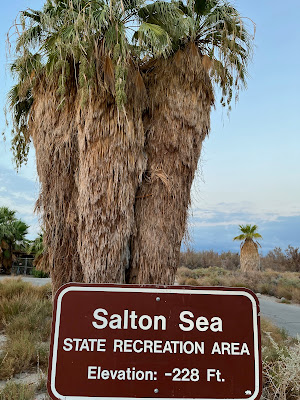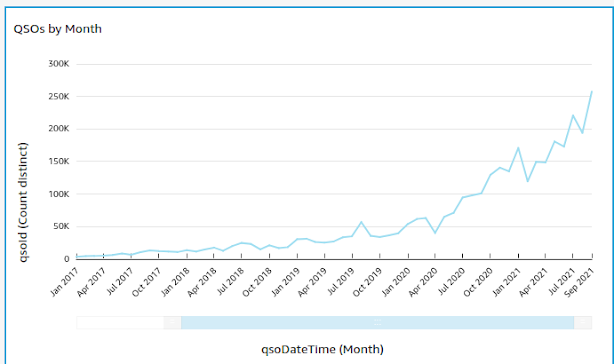In Defense of Dupes
The Angeles Crest Highway is a remarkable bit of 1930s engineering that winds its way some one hundred kilometers along the ridge of the San Gabriel Mountains—the mountain range that rises to the north above Los Angeles—from La Cañada to Wrightwood. Much of the route traverses the San Gabriel Mountains National Monument (POTA K-4544), which was carved out of the Angeles National Forest in 2014.
The choice of prepositions turns out to be important. The highway winds along the ridge, not on the ridge. On a warm-but-not-too-warm day in early July of 2022, my wife and I met up with a good friend of ours to drive the length of the highway and stopped about midway to spend a little time picnicking and activating the park. The good news is that the picnic spot we stopped at had excellent lines of sight to most of the Southern California basin, and I made enough contacts on 146.520 MHz to have logged a successful activation without even needing to power up the HF rig. The not-so-good news is that getting an HF signal over the mountains to my north and east proved daunting. Ultimately I made a baker's dozen contacts on twenty meters CW, but the signal reports were nothing to write home about, almost all of the contacts were in California, and none of the contacts were east of the Rockies.
About halfway through the activation, I heard a station responding to my CQ call on 14060 kHz. The call sign sounded familiar. A quick glance at my paper log1 revealed what I suspected: I had already worked that station not quite an hour before on the same band and same mode. The contact would't count for POTA, and would do neither me nor the other operator any good in terms of progress toward POTA awards. I was about to send B4 TNX 73, but something in the back of my mind told me not to. Instead I sent a signal report and QTH, got the same in response, and thanked the operator for the contact with a 73 and a dit-dit. The station was NI6BB. I didn't recognize it at the time, but that is the call sign for the club that operates in the radio room of the Battleship Iowa, now a museum ship in San Pedro, California. The club sometimes welcomes radio amateurs who are visiting the ship to spend a little time operating the station. On a Saturday morning, hunting POTA is a good way to make a few quick contacts, so it's not surprising that NI6BB was doing just that. I might never know for sure, but it is entirely possible that the two contacts were two different guest operators, passing through the radio room at two different times. To deny the second operator a chance at a contact out of concern that it somehow wouldn't count would not have been the most considerate thing in the world; I'm truly glad that I took the sixty seconds to complete the contact.
Aside from whether FT8 is ruining amateur radio, few topics seem more capable of stirring controversy among the amateur radio community than that of duplicate contacts. Ham radio Twitter is full of complaints about how two operators who have worked each other by satellite dozens of times feel the need to say hello yet again while a rover is positioned in a rare grid square, depriving operators who are interested in logging grid squares a chance at a contact during the limited time a satellite is overhead. We see similar complaints about operators working rovers in grid squares that they've already logged. A narrow majority of responses to a recent Twitter poll expressed support for previous Gridmaster recipients refraining from working rovers on FM satellite passes.
Ham radio Twitter isn't entirely wrong in raising concerns about inconsiderate on-air behavior that consumes valuable time and bandwidth at the expense of other operators. The name-calling that we sometimes see isn't helpful though. Attempts to define unwritten rules that limit duplicate contacts is more helpful, but they still come with the risk of limiting our flexibility. Not every contact is going to be—or needs to be—an all-time new one. Not every satellite pass is a pileup. Rovers and activators and DXpeditioners and even astronauts (more on that last one later) are all hams just like you and me. Every time they fire up the rig, they'd rather make contacts than not make contacts. Changing ionospheric conditions, changing satellite health, and changing geometries between ground station and satellite means there's potentially something to learn with every QSO. Instead of a set of rules limiting or disallowing duplicate contacts, maybe we'd be better served if operators followed a few broad and overarching principles, principles like awareness and courtesy and consideration for fellow hams.
On a sweltering early Sunday morning in August of 2022, I stood on the shore of the Salton Sea, activating POTA entity K-3552. At 0635, the International Space Station passed over well to the north, but within sight of my QTH. The track of the pass would carry the station over the Pacific time zone, and a sparsely populated2 region of the Mountain time zone. The station would pass over portions of the American West where either nobody was home or nobody was awake. Ironically, it would be the perfect time to make a few QSOs. The relatively uncrowded conditions would allow me to make contacts with the few operators who were up at this hour with little or no QRM. At AOS, I pointed my Arrow antenna just above the horizon.
"NA1SS listening." Rather than a ground station, I was hearing astronaut Kjell Lindgren doing what he has so generously spent much of his time on orbit doing: working amateur stations on the ground.
Back in June of 2022, I had already had the privilege of working NA1SS from my home QTH. To make a second contact with the station, when so many hams are still trying to make their first is frowned upon in the amateur radio community—almost taboo.
"NA1SS listening."
Ordinarily it's an enormous pileup when NA1SS is on the air. The earliness of the hour appeared to have caught everyone on the West Coast off guard.
"NA1SS listening."
He took time out of his busy schedule to pick up the mic and try to make contacts. We had reached the point where it would be inconsiderate not to work him.
"NA1SS, W6KSR. Parks on the Air."
"W6KSR, NA1SS. Welcome aboard the International Space Station."
"And welcome to the Salton Sea State Recreation Area. You will get credit for the park today."
"Outstanding. I hope to visit there someday."
"NA1SS, W6KSR. Thanks a bunch for the contact and 73."
"73."
A few stations worked NA1SS after my contact. Everyone got their chance. I didn't detract from anyone else's enjoyment, and in some small way I might have contributed to making that orbital morning a little more enjoyable for the operator on the other end. It's a QSO that I'll always cherish—maybe even more than that rushed first contact—and when Dr. Lindgren arrives back on the ground, a few months from this writing, I hope he gets that chance to visit one of the oddest and most unique spots in California.
1. Yes, I use paper log sheets in the field, and then transcribe to my home-brewed logbook program when I get home, but that's another story.
2. The terms sparsely populated and Mountain time zone might be redundant, but on this pass the station was well into the northern reaches of the US Mountain time zone.





Comments
Post a Comment